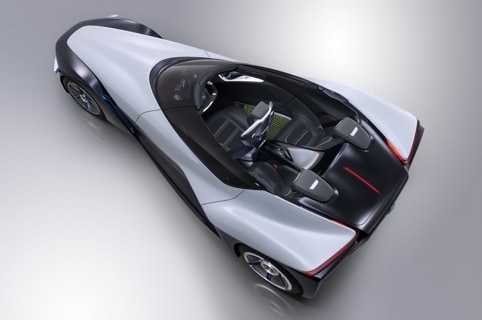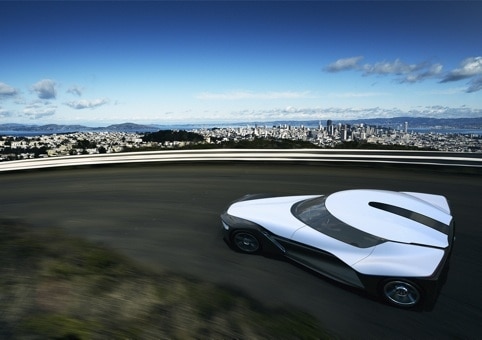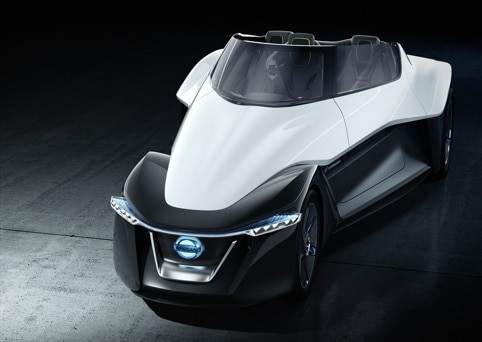
We all know a sports car when we see one. There’s shared design DNA between most of the fast two-seaters on the road: a scrap of Jaguar E-type here; a bit of Porsche 911 there; a dash of Ferrari Enzo for seasoning. So when a concept appears that comprehensively scraps that design heritage it does tend to attract attention, especially when it’s put forward by one of the largest and most commercially successful automotive companies in the world.
The Nissan BladeGlider, which made its debut in concept-car form at the Tokyo Motor Show last November, is radically different from any car on the road. This in itself isn’t unusual for concept cars: they’re a chance for the automotive industry’s design engineers to indulge their imaginations and present a vision of the future. But Nissan is serious about the BladeGlider. Product planning chief Andy Palmer has said that the company is intending to put the car into full production in the next five years.
BladeGlider is an electric vehicle, and Nissan’s design department has used the design freedom that allows to reshape the familiar plan of a car. Rather than rectangular and boxy with a need to enclose an engine and exhaust system, the car is triangular, with the narrow front wheels set close together and wide rear wheels much further apart. Resembling more than anything else the cockpit of a single-seat fighter jet chopped off from the fuselage and set on four wheels, the car is a three-seater, with the driver sitting between and in front of two passengers.

Regular readers of The Engineer might recognise the layout as being similar to an eye-catching radical racing car design of a few years ago. The Deltawing Racer, which we described as looking like a Batmobile crossed with a jet fighter, ran at the Le Mans 24-hour endurance race from Garage 56, the slot reserved for experimental vehicles, with sponsorship from Nissan. Deltawing’s designer, British automotive engineer Ben Bowlby, is now director of motorsport innovation at Nissan and has developed an electric successor for Nissan, the ZEOD RC (zero emissions on demand racing car), which will take this year’s Garage 56 spot. He acted as a consultant to the BladeGlider design team.
‘BladeGlider’s layout is not unique,’ Bowlby told The Engineer. ‘You see that narrow front-track, wide rear-track configuration elsewhere: in Bloodhound SSC, for example. There was a lot of scepticism at Le Mans because it went against the conventional wisdom of car design; some people thought we’d go off at the first corner,’ he added. ‘But we proved that it works.’
It’s not just for show. The narrow front track reduces drag, offsetting the downforce created by the car’s moulded carbon-fibre underbody, which the company will not discuss. The weight distribution is similarly rear-heavy, with a 30:70 ratio front to back, all of which helps the car to make high-g manoeuvres at speed.

To help with that weight distribution, the BladeGlider’s batteries — it uses the same lithium-ion technology as the Nissan Leaf electric vehicle — are low down at the back of the vehicle, as are the electric motors that power the car. Nissan will not divulge the power rating of the motors in either the concept or planned production versions, but they are wheel-mounted, with one motor per wheel which can be managed independently of each other and deliver instant torque. Independent motor management allows the torque from each wheel to be varied, which further keeps the car stable in corners (it limits oversteer — when the car’s back wheels start to slide towards the outward edge of a curve — producing an effect similar to the limited-slip differential in a conventional performance car).
All of this, Nissan claims, will produce a car that handles with a floating, glider-like feel, which is enhanced by the driver and passengers’ central placing in the vehicle and the large wraparound windshield, which curves smoothly around the sides of the car. To add to the glider-like cues, the concept car features an aircraft-style steering wheel and an infotainment system that displays relief maps and weather conditions. ‘I think that the excitement of the racing car should be mirrored in the excitement of driving the road car,’ Bowlby said. ‘I think there are elements we can bring from the race track to make these future road cars more exciting, more fulfilling and give greater driving pleasure.’
According to Palmer, the BladeGlider will go onto Nissan’s production slate in the next five years, joining another concept sports car, the IDx coupe, which is designed to be an entry-level lower-cost model. The BladeGlider is intended to change the image of the electric vehicle, being a high-spec, high-performance vehicle with a range of 200 miles with a single charge and for a relatively low price — Palmer estimates it will cost less than £30,000.



Swiss geoengineering start-up targets methane removal
Several rather dubious statistics in this report. IF methane had 120× the thermal effect of CO2 that would be TWO orders of magnitude. Two is not...